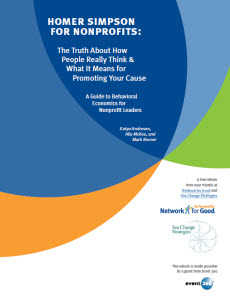 What does Homer Simpson have to do with your cause? More than you probably think.
What does Homer Simpson have to do with your cause? More than you probably think.
People including your activists, donors and prospects share a lot in common with Homer Simpson. And I don’t just mean they love bacon.
We might not want to admit it, but people make irrational, Homer-like decisions every day. We cave to social norms. We opt for small, immediate satisfaction, rather than big long-term gain. We buckle to authority. 
The list of illogic is long. And it adds up to making decisions that are often contrary to our own best interests.
But while we may be irrational, we are not unpredictable.
Enter in behavioral economics.
A reaction to “rationality”— the concept that people use logic and reason to make the best choices for themselves — behavioral economics identifies social, cognitive, and emotional factors that influence decisions.
The big takeaway? People make decisions like Homer Simpson, not Spock.
What’s more, in the nonprofit space these irrational decisions have high stakes. We’re not asking people to buy a Coke. We’re asking them to change the world. Their decisions matter — a lot.
So what’s a nonprofit marketer and fundraiser to do?
In the Network for Good and Sea Change Strategies eBook, Homer Simpson for Non-Profits: The Truth about How People Really Think and What It Means for Promoting Your Cause, we identify 8 guiding principles gleaned from recent behavioral economics research that might just change the way you approach nonprofit marketing and fundraising.
These principles will help you explore the psychology behind decision-making so you can craft more effective messages that will win the hearts and minds of your audience.
We provide concrete examples and takeaway lessons that you can put into practice immediately.
Some ideas to look forward to:
- Small, not big – The bigger the scale of what you’re communicating, the smaller the impact on your audience. If you want to communicate with your audience on the scale they comprehend — a human scale — then take the big issue your organization addresses and communicate it through stories about one person, one whale, one tree.
- Hopeful, not hopeless – One reason for thinking small is that people tend to act on what they believe they can change. If your problem seems intractable, enormous and endless, people won’t be motivated to help. They want to know there is something — anything — that they can fix.
- Peer pressure still works – Nope, it doesn’t end after high school. People are more likely to do something if they know other people like them are doing it. Like dogs in a pack, people take strong cues from one another. Incorporating these social cues into your messages can help galvanize your supporters to act and give on your behalf.
- Stick to social norms, not market norms – Humans have two distinct decision making rulebooks. Social norms are governed by values of community, selflessness and altruism. Market norms are governed by calculated self-interest. Social norms are stronger motivators. But if you mix the two rulebooks, market norms will eclipse social norms.
So what are you waiting for? Learn how to deal with all the Homers out there and download the eBook for free today.
This eBook was written by Katya Andresen and Alia McKee with help from Mark Rovner, and is made possible by a grant from Event 360.
Alia McKee is a principal of Sea Change Strategies, a boutique strategic marketing and fundraising group specializing in high intensity partnerships with remarkable causes.


COMMENTS